Curating Courage and the Future of Latinx Theatre / Valentía Curatorial y el Futuro del Teatro Latinx
Every person who picks up a pen is a writer, but the one in active pursuit of transcendence through a rigorous journey of courageous on-their-feet defeats is a playwright. A playful creator imagines a world, but the tenacity of an intrepid visionary makes a director. A life on the stage would be simply pretend if not for the tangible things that make color, texture, ambiance, and space. We can all agree that theatre does not happen in the vacuum. And though it does exist and thrive without hierarchies or titles, without the games and the rules (as proven by our ancestors’ practice of ritual, ceremony, and other theatrical forms in this land since before chicken pox), the Theatre of Always will always require you and an other. We were reminded of this at the recent 2018 Latinx Theatre Commons Carnaval of New Latinx Work: a three-day festival of six new new plays at The Theatre School at DePaul University in Chicago, IL. The theme? ConeXión!
Latinx Theatre is not simply looking to identify itself within the frame of the “Anglo-sphere” as much as it is a new form of theatrical language that seeks to create the best work of art possible.
This idea of “the other” can mean more than one thing, and perhaps that’s the reason it is so present in the art of Latinx folx. As an immigrant, I realized quickly that to live and function “between cultures” was inevitably my new state of being. I realized that I had suddenly become “the other,” and in that dispossession of self as whole, I learned to see the other as part of me. In that search of connection to the other, new idioms are born. My childhood home was full of made up words like “yaqué,” meaning “ya que estás parado traeme…” or, “now that you’re up, will you get me this or that.” These shortcuts to meaning, these made up words that belong “just to us,” are a chief way to use the language of colonizers creatively to make gest, create familiarity, and, in the case of Latinx Theatre, make waves.
The idea of the other as an active participant in the realization of a whole self is part of what makes Latinx Theatre a vibrant laboratory in the constant search for common meaning, and a common language. Latinx Theatre is not simply looking to identify itself within the frame of the “Anglo-sphere” as much as it is a new form of theatrical language that seeks to create the best work of art possible. The Latinx writer is he/she/they who communicates in a creative way their own “yaques,” and, with their fellow Latinx artists and audience, propagates unique messages and experiences which are singular to us as Latinx people, and yet are still universal.
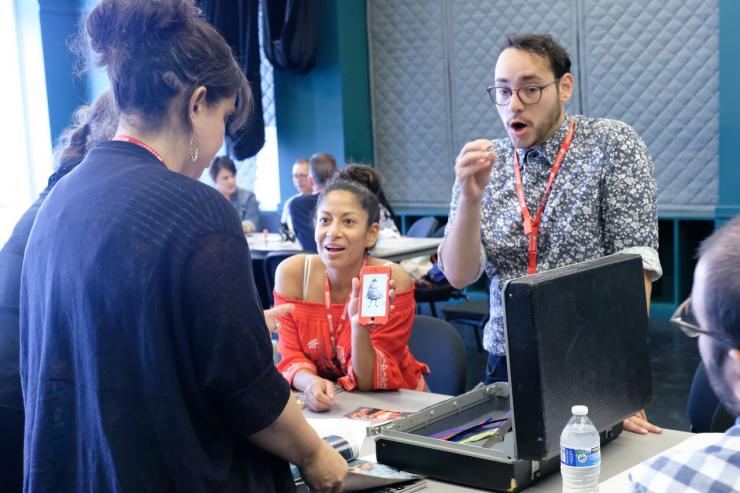
Connection between people, like the connection between text and audience, is not only ancient but powerful and, in truth—a radical act. It makes me remember the words of Marshall McLuhan, the Canadian professor, philosopher, and intellectual who said, “Of all the great hybrid unions that breed furious release of energy and change, there is none to surpass the meeting of literate and oral cultures. The giving to [wo]man an eye for an ear is probably the most radical explosion that can occur in any social structure.”
Latinx Theatre lives in that hybridity in that it gives its audiences an eye for an ear. We see what we hear, and we listen to what we see. It was for this reason that I was personally invested in seeing this year’s Carnaval festival include the many others that make up theatremaking, chiefly, those who invite semiotic language: designers. As a playwright who paints, I have always felt a tremendous emptiness witnessing my plays read out loud. Yes, I can paint the picture with words, but the nature of theatre is that it invites and questions the very conflict between word and image. I joined the 2018 LTC Carnaval Programming Committee to help ideate the shape and the ways this festival could incorporate a Design element to bring us back to these powerful truths of connection, collaboration, and theatremaking.

This idea to incorporate designers played in concert with what Lisa Portes, champion of both the 2015 and 2018 Carnavals, had wanted to add: a robust support team that could elevate and sustain the work of this year’s featured playwrights. She brought in a team of Latinx directors to work on the readings of the plays, and turned to Chris Acebo and Isaac Gomez to do the same for Designers and Dramaturgs, respectively. During the Carnaval Opening Ceremonies, she shared some staggering statistics with us, one which stuck with me: less than 4 percent of directors hired in LORT theatres at a national level in the US are Latinx. I can’t imagine what small percentage of that constitutes women, and how many productions in the country hire Latinx dramaturgs and designers at all.
A driving force behind this year’s Carnaval was to provide a peek into the vast world of existing Latinx talent. There was careful and heartfelt curation behind the selection of this year’s directors, designers, and dramaturgs. The goal was to match each of them with a playwright and a play which, based on their own artistic sensibilities, they could critically aid in elevating and furthering. In my opinion, the biggest mistake of the 2015 iteration of the festival was that, in a wish to “flood the pipeline,” the playwrights were left to fly solo in the representation of their pieces. It was as if the play was suddenly expected to be perfect on its own, ignoring completely the elemental need of collaborative support that makes a new play development process work.
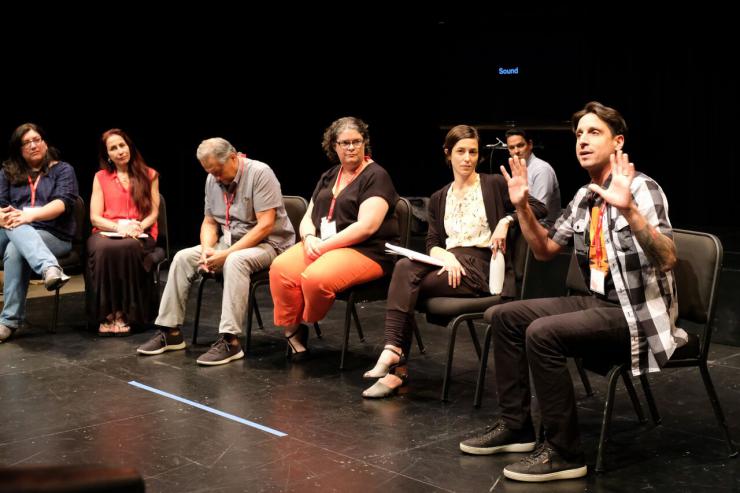
We learned. And though we have to acknowledge the problems with curation—things such as privilege and favoritism and the danger therein—it’s important to keep in mind the impact that these Latinx festivals can continue to have if we are courageous enough to reshape their structure and form. We should want any event or program that champions Latinx work to have universal appeal, for our field, for society, and our community. And as they say in my country to warn of the trap of negativity and worrying about what others are doing to you instead of what they can do for all, “If you’re not drinking the water, just let it run.”
It takes courage to create. As artists we must act generously and not with greed. We must have courage to defeat comfort. In fact, it is expected of us. We must choose to learn from our artistic work as we learn from life. We should strive to learn from our mistakes as we do from our successes. We would be in peril as an artistic community if the mistakes of the past did nothing to us but inflate our ego. The illusion of success in the world of art is dangerous: it can disconnect us from our community and from those who are in most need of our work. It is important then that these festivals and convenings do not idolatrize an individual, but that they advance and better the artistic work. And in that way, I applaud the Curators with a heartfelt snap-snap. Director Lisa Portes mentioned in her Opening Ceremony remarks that a dramaturg once told her, “I love the writer, but I love the play more.” This was the northern star in what I heard from Lisa, Isaac, and Chris when it came to selecting the group of directors, dramaturgs, and designers. They all sought to bring forth people from various experiences, who would be generous in joining the writer and “meeting the work where it’s at” to collectively project the best image of the text at hand. Involving designers in the process was a surprisingly key element in elevating the work this year. I wasn’t wrong in thinking we needed to give eyes to our ears.
The Carnaval, outside of the curation and the work presented, had a strong centrifugal force: that of connection. Any society which accomplishes incredible feats leaves behind the residue of an absolute truth: they were a united community. In the world of Latinx theatre, it has become more than obvious that if divided, we will never accomplish the great changes that need to happen to make for more equitable national practices in selection, hiring, and production. Indeed, the Carnaval’s “theme” and appearing on all of our swag was the point of Conexión, or connection.
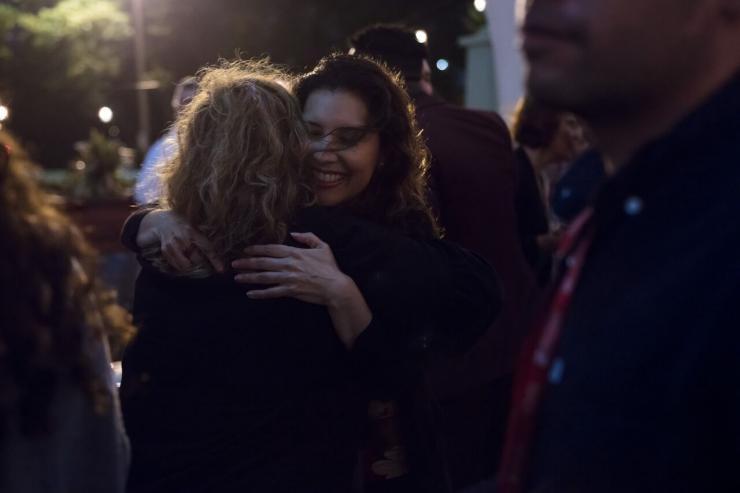
Among the celebratory buzz, however, was the acknowledgement that what we had present was just a peek into something much larger. In regards to her selection of directors, Lisa said, “Within the context of the Carnaval we sought to amplify the voices of six Latinx directors knowing that they are just the tip of the iceberg when it comes to terrific Latinx directors around the country.” This was true of the selection of plays, which underwent a rigorous selection process via committee. The festival smartly tightened its language in adhering to the fact that it exists to feature new plays, and not to promote new playwrights. In the spirit of you as the other and the other as you, this year was all about connection and collaboration over individual achievement.
With the help of designers, directors, and dramaturgs, and the response of every person who attended, the Carnaval became a play in itself, filled with laughter, tears, frozen extremities, bouts of hunger, and collective growth.
The 2018 Carnaval is just the beginning. It is only the second stone in what will be a cascade of courageous gathering, doing, and making. But the Carnaval fulfilled its mission: as Lisa wrote in her program note, it presented plays whose characters fought to “redefine the rules, reimagine what’s possible, and push past false boundaries, insisting on a larger world” and it did it with the support of others who imagined these stories alongside the authors and made them feel less alone in the process. With the help of designers, directors, and dramaturgs, and the response of every person who attended, the Carnaval became a play in itself, filled with laughter, tears, frozen extremities, bouts of hunger, and collective growth. And with this ancient form of minor magic, the one of connection, societies have not just survived but transcended. The future of Latinx artists and art making looks bright, should we take care to continue in the spirit of courage and resist every urge to cast, write, think, act, design, or do out of comfort.
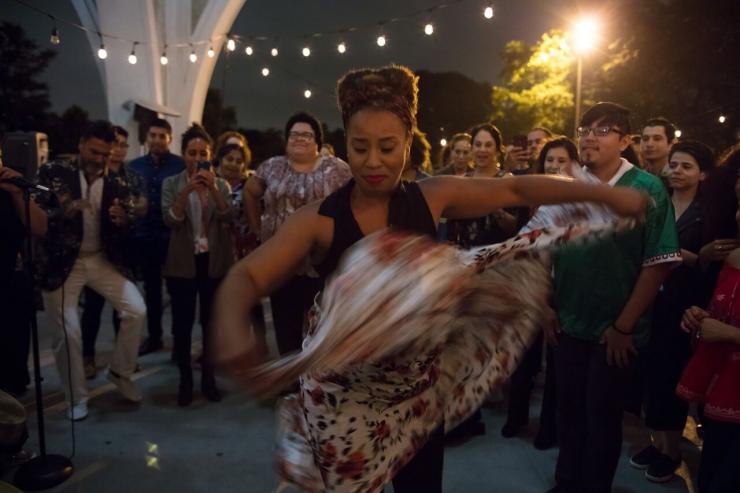
It takes courage to create, and I believe it takes the same courage to curate. If we change our perspective to see curation as “gathering” rather than presenting, then we can believe that the gathering continues after each harvest, and that the act of curation is courageous in that it doesn’t stop with “the tip of the iceberg.” In the Anglo-sphere of our theatre, courage drives where comfort resides, it propels where fear pulls back, and it lifts up where austerity stifles. The art of people of color has lived and promises to continue to thrive under one absolute principle: courage. That in itself is our “yaque,” our common language, our conexión.
***
Todo aquel que tome la pluma escribe, pero es aquel quien activamente busca trascender por medio de la derrota a la hora del montaje que se considera dramaturgo. Un individuo creativo crea mundos, pero es aquel visionario intrépido y tenaz quien se convierte en director de escena. El mundo escénico seria solo plástico si no fuese por los elementos tangibles que son las luces, el vestuario, y el medio ambiente sonoro. Podemos acordar que el teatro no se crea en el vacío. Y aunque si existe y florece sin necesidad de la jerarquía o de los títulos, sin las reglas del juego (como lo comprobarán nuestros ancestros quienes por medio del ritual y la forma teatral practicaron este medio desde mucho antes que nos llegara el sarampión), el Teatro de Siempre necesitara eternamente de ti y de otro para poder existir. Esto mismo fue algo que se presentó recientemente en el 2018 Latinx Theatre Commons Carnaval of New Latinx Work: un festival que en tres días presentó seis obras nuevas escritas presentada en la escuela de DePaul en Chicago, llamdo: ConeXión!.
El teatro latnix no solo busca identificarse dentro de los parámetros de la ‘anglo-esfera’ si no que busca crear su propio idioma teatral para así poder expresarse y crear el mejor arte posible sin tener que luchar con el ser entendido.
La idea de “el otro” significa más de una cosa, y es por eso que tal vez se presenta con frecuencia en el arte de las personas de raíces u origen latinx. Siendo inmigrante, se me hizo claro desde un principio que el precio de mi instancia en este país significaría el vivir ‘entre dos culturas.’ Me di cuenta que en verdad pertenecía yo a ese grupo llamado “el otro” y que en esa pérdida del Yo completo, aprendería la apreciación del “otro” como me apreciaría a mí misma. En esa búsqueda de conexión con aquellos tantos ‘otros’ nacen nuevos idiomas. En mi hogar, teníamos una serie de palabritas como “yaqué” que quería decir “ya que estas parado tráeme esto o lo otro.” Este tipo de idioma abreviado, de códigos lingüísticos cuyos perteneces a solo un grupo de personas son la forma más tangible de luchar contra el idioma del colonizador o del opresor y la manera en que la gente de mi cultura busca familiaridad y amistad, y en el caso del teatro latinx, la forma más tangible de crear simbolismo en común.
Es así que ‘el otro’ se convierte en una parte activa rumbo a la realización de un Yo completo, y es parte indeleble de lo que convierte al teatro latinx en un laboratorio vibrante en la búsqueda de un idioma en común, de una lengua hermana. El teatro latnix no solo busca identificarse dentro de los parámetros de la ‘anglo-esfera’ si no que busca crear su propio idioma teatral para así poder expresarse y crear el mejor arte posible sin tener que luchar con el ser entendido. El escritor latinx es aquel quien de forma creativa inventa sus propios “yaques” para que así junto con otros artistas latinx y con su público comparta mensajes y experiencias únicas a las personas de raíces u origen latinx, y convierte su mensaje en un mensaje universal.
La conexión entre las personas, como la conexión que existe entre el texto y el público, no es solo un mecanismo antiguo pero algo con verdadero poder y, en verdad—un acto radical. Vale recordar las palabras de Marshall McLuhan, profesor, filósofo e intelectual Canadiense quien dijo, “De todas las grandes formas híbridas que generan una furiosa liberación de energía y cambio, no hay ninguna que supere el encuentro de las culturas letradas y orales. Darle al público ojos por oídos es probablemente la explosión más radical que puede ocurrir en cualquier estructura social.”
El teatro latinx vive en ese estado híbrido cual busca darle a su público ojos por oídos. En otras palabras, vemos lo que escuchamos, y escuchamos ante lo que vemos. Es por esta razón que yo estuve personalmente involucrada con el festival de Carnaval de este año y en específico, me motivo el ver la inclusión de aquellos ‘otros’ que forman parte de nuestra practica teatral, especialmente, aquellos que usan el lenguaje de la imagen: los diseñadores. Siendo una escritora que pinta, siempre he sentido un tremendo vacío al escuchar las lecturas de mis obras. Si, podre pintar la idea con mis palabras, pero el teatro por naturaleza es aquel que invita a preguntar y a poner ante ojos y oídos el conflicto entre la palabra y lo visual. Me uní con esto en mente al grupo encargado de la programación del Carnaval 2018 para ayudar a idear formas en las que podíamos activar el aspecto del Diseño con tal de devolvernos estas grandes verdades de lo que es la conexión en la creación de obras teatrales.
Esta idea de incorporar a los diseñadores fue parte también de lo que la directora y campeona de ambos festivales, 2015 y 2018, Lisa Portes, tenía en mente: el unir a un grupo robusto que pudiese ayudar a elevar y a apoyar el trabajo de los escritores y de las obras seleccionadas este año. De esta forma, la directora invito a un grupo de directores latinx para que dirigieran las obras, e invito a Chris Acebo y a Isaac Gómez para que hicieran lo mismo e invitaran a un grupo de diseñadores y dramaturgos (investigadores de texto) respectivamente. Durante las ceremonias de apertura del Carnaval, se compartieron estadísticas redundantemente negativas acerca el teatro en el país, inclusive que menos del 4 por ciento de los directores contratados para dirigir en teatros regionales a nivel nacional son de raíces u origen latinx. No puedo imaginar cuántos de esos son mujeres, y aun peor cuantas producciones en el país contratan a dramaturgos y a diseñadores latinx.
Una de las metas detrás del festival Carnaval este año fue precisamente el poder brindar a su público solo una ojeadita a la cantidad de talento latinx existente en nuestro país. No se trataba simplemente de presentárnoslos, sino de presentar también por medio de su elección un rigor curatorial que de otra forma a estado ausente en nuestros festivales. La meta era unir a cada director, diseñador y dramaturgo con aquella obra cuya, basada en su estética personal, pudiese ser expresada y presentada de la forma más profesional y no solamente como apoyo banal, y de esta forma poder elevar el material. Seamos honestos, esto hace falta. Está bien que nos echemos porras como artistas, pero si no empezamos a ser honestos sobre nuestro trabajo artístico y de esta forma someterlo al mismo objetivismo y análisis crítico necesario para construir la mejor obra, corremos el riesgo de aislarnos y de no avanzar la forma artística de nuestra comunidad. Si no avanzamos como comunidad, en este país corremos el riesgo de avanzar jamás como individuos (¿recuerdas la cifra anterior?) En mi opinión el peor error que se cometió en el festival del 2015 fue que en su entusiasmo por introducir gran cantidad de material artístico, los artistas en si se abandonaron y la representación de las obras se dejaron al vacío y ante un público cruel y expectativo. Fue como si de repente el mundo artístico esperara de estas lecturas una perfección ilógica, y se ignorara de esa manera el elemento básico de lo que es la colaboración y el apoyo en un proceso de desarrollo de esas nuevas obras teatrales.
Pero se aprendió. Y aunque es necesario el reconocer la gran problemática que existe en todo proceso curatorial tal como el elemento del privilegio o el favoritismo—es importante el recordar en el impacto global que pueden tener si seguimos con valentía cambiando sus estructuras y formatos. Deberíamos de si apoyar a cualquier programa o evento que le dé lugar al trabajo latinx ya que de esta forma le damos significancia universal, y podemos cambiar así nuestra rama artística, nuestra sociedad, y nuestras comunidades. Y como decimos los mexicanos cuando se trata de la negatividad abundante para advertir de no meter veneno en el pozo, “agua que no has de beber, déjala correr.”
Es cosa de valientes el crear. Como artistas debemos actuar con generosidad y no con avaricia. Debemos tener la valentía para actuar activamente en contra del confort. De hecho, esta es la expectativa. Debemos así elegir a crecer ante el aprendizaje que nos brindan nuestros errores como crecemos con nuestros éxitos. Estaríamos en gran peligro como comunidad artística si los errores del pasado no sirvieran de nada más que para alimentar el ego. La ilusión del éxito en el mundo artístico es muy peligroso: puede desconectarnos de nuestra comunidad y de aquellos que más necesitan de nuestro trabajo artístico. Es importantísimo que en estos festivales y reuniones no idolatrásemos al individuo, si no que ayudemos con todo lo que se pueda a avanzar el trabajo artístico hasta llevarlo a su mejor potencial. Y con esto en mente, le brindo un aplauso al equipo curatorial de este festival. La directora Lisa Portes menciono en las ceremonias de apertura que en alguna ocasión le menciono una dramaturga (o investigadora de texto) que “Amo al escritor, pero amo más a esta obra.” Este pensamiento funciono como punto Norte para los curadores cuando trató de su trabajo curatorial. Cada uno busco unir a personas de variadas experiencias artísticas quienes pudiesen unírsele al escritor y al material desde un punto en común con tal de juntos proyectar la mejor imagen y representación del texto. La involucración de los diseñadores comprobó ser un gran elemento en levantar el texto, y me comprobó a mí que no estaba equivocada en querer darle ojos a nuestros oídos.
El Carnaval, más allá de trabajo curatorial y de las obras presentadas, se presentó con una fuerza centrífuga: el de la conexión. Cualquier sociedad que llega a cumplir con grandes hazañas deja el residuo de una gran verdad: eran una comunidad unida. En el mundo del teatro latinx, es más que obvio que divididos jamás cumpliremos con los grandes cambios que son necesarios rumbo a la igualdad e exclusividad en nuestras prácticas nacionales de selección, presentación, y producción. Por esto mismo, el tema de conexión en este Carnaval estuvo presente durante todo el fin de semana.

Aun en el entusiasmo de la reunión, sin embargo, no ignoro la curadora y campeona del festival que los presentes representaban simplemente un pequeño porcentaje de algo mucho más grande. Cuando se le pregunto sobre su selección de directores, Lisa comento, “Dentro del contexto del Carnaval, busque amplificar las voces de seis directores latinx con el total reconocimiento que estos son solo la punta del iceberg cuando se trata de los tantos directores latinx de tremendo talento en nuestro país.” Esto fue cierto también cuando se trató de la selección de las obras presentadas, ya que los seleccionados pasaron por un estricto y rigoroso proceso de adjudicación no desigual a los mejores centros de desarrollo artístico en el país. Pero si en verdad aprendemos de nuestra historia, entonces puedo decir que en verdad se hizo claro en este festival que éste existía para darle voz a nuevas obras y no a nuevos escritores. Con esa mentalidad del ‘tú eres mi otro yo,’ el festival de este año trato de la conexión y de la colaboración como precedente a los logros individuales.
Con la ayuda de los diseñadores, directores, y dramaturgos de texto, y con la energía de todos los presentes, el Carnaval se convirtió en una obra en sí, llena de risas, tragedias, extremidades congeladas, hambría, y el crecimiento colectivo.
El Carnaval 2018 es solo el principio. Es solo la segunda piedra en lo que debe ser una avalancha de reuniones, creaciones, y producciones formadas con la energía de la valentía y no del confort. Dentro de lo que cabe, el Carnaval cumplió con su misión: como lo dijo Lisa en su nota, el festival presentó obras cuyos personajes luchaban con “redefinir las reglas, imaginar lo imposible, y el vencer de los limites falsos al insistir en el que hay un mundo mucho más grande” y logró esto con el apoyo de otros quienes se atrevieron a imaginar estas historias junto con el autor y ante todos aquellos que le hicieron sentir menos solo en el proceso. Con la ayuda de los diseñadores, directores, y dramaturgos de texto, y con la energía de todos los presentes, el Carnaval se convirtió en una obra en sí, llena de risas, tragedias, extremidades congeladas, hambría, y el crecimiento colectivo. Y con esta forma de crear magia antigua por medio de la conexión, varias sociedades unidas no solo han sobrevivido sino transcendido. El futuro del artista latinx y del arte que éste crea tiene un futuro radiante si es que continuamos a invocar el espíritu de valentía en la forma en la que creamos, contratamos, escribimos, diseñamos, y actuamos.
Es valiente el que crea y quisiera pensar que toma el mismo valor la practica curatorial. Si cambiamos nuestro pensamiento a pensar del proceso curatorial como un ‘reunir’ de talentos y no de ‘presentarlos’ entonces podemos descansar sabiendo que la asamblea continua con cada cosecha, y que el acto curatorial toma valentía en el simple hecho de que no le basta con solo demostrarnos ‘la punta del iceberg.’ En la ‘anglo-esfera’ que constituye nuestro teatro actual, el valor y la valentía es la que triunfa ante el confort, es la que impulsa donde el miedo jala, y la que levanta donde la austeridad apaga. El arte de la gente de color, del pueblo del marginalizado, vive y triunfa bajo la promesa de la continuación de un principio absoluto: la valentía. En sí, se puede decir que la valentía es nuestro “yaque,” nuestro idioma en común, y nuestra más fuerte conexión.

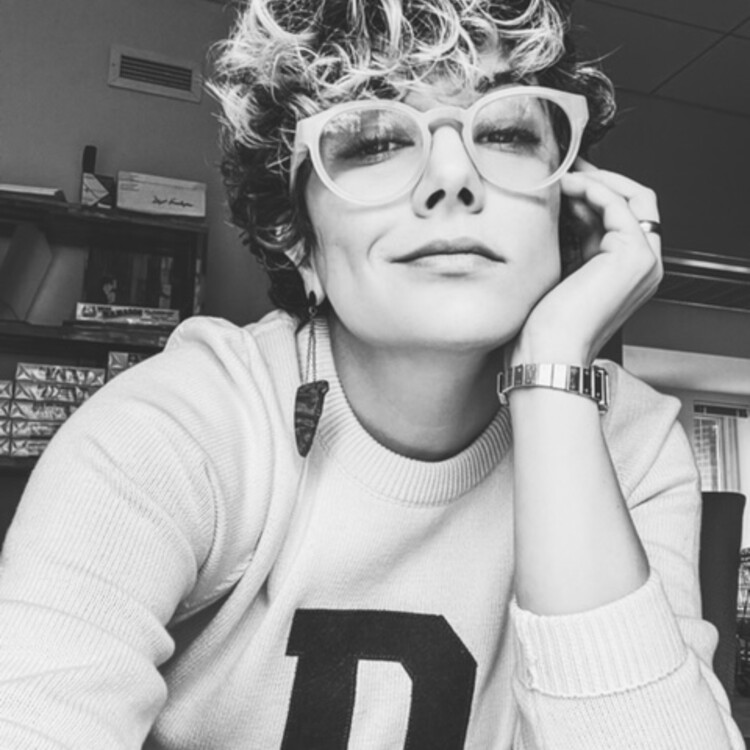
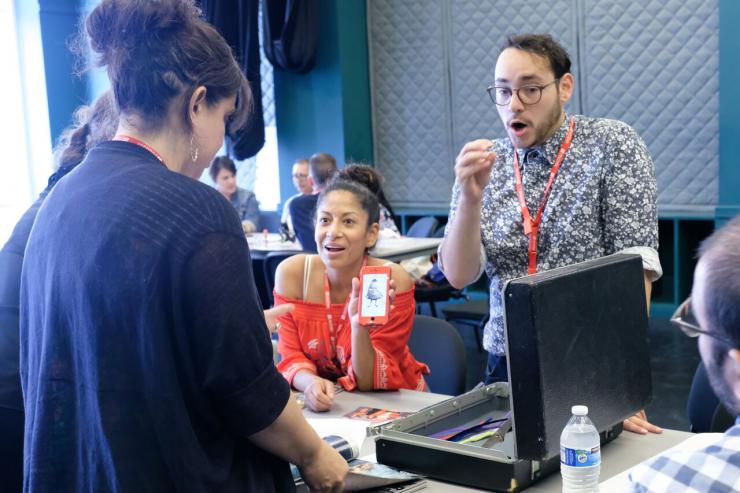
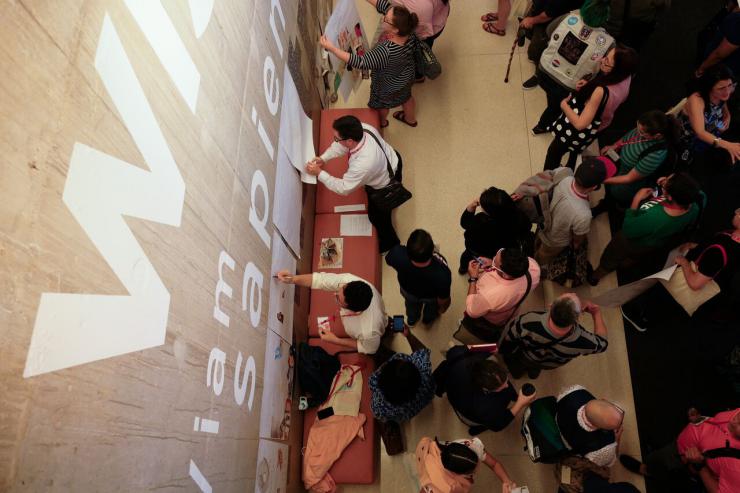


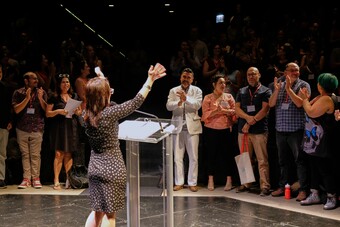

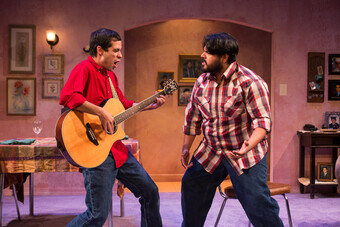




Comments
The article is just the start of the conversation—we want to know what you think about this subject, too! HowlRound is a space for knowledge-sharing, and we welcome spirited, thoughtful, and on-topic dialogue. Find our full comments policy here